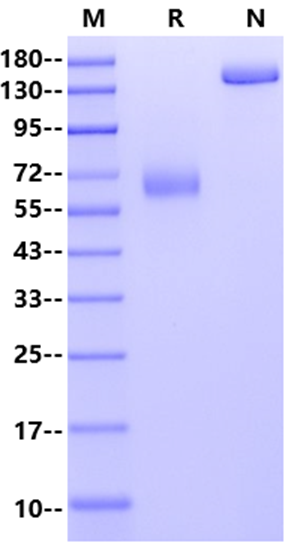

 下载产品说明书
下载产品说明书 用小程序,查商品更便捷
用小程序,查商品更便捷



 收藏
收藏
 对比
对比 咨询
咨询
Met20-Ser220, with C-terminal Human IgG Fc MVPPPENVRMNSVNFKNILQWESPAFAKGNLTFTAQYLSYRIFQDKCMNTTLTECDFSSLSKYGDHTLRVRAEFADEHSDWVNITFCPVDDTIIGPPGMQVEVLADSLHMRFLAPKIENEYETWTMKNVYNSWTYNVQYWKNGTDEKFQITPQYDFEVLRNLEPWTTYCVQVRGFLPDRNKAGEWSEPVCEQTTHDETVPSIEGRMDPKSSDKTHTCPPCPAPELLGGPSVFLFPPKPKDTLMISRTPEVTCVVVDVSHEDPEVKFNWYVDGVEVHNAKTKPREEQYNSTYRVVSVLTVLHQDWLNGKEYKCKVSNKALPAPIEKTISKAKGQPREPQVYTLPPSRDELTKNQVSLTCLVKGFYPSDIAVEWESNGQPENNYKTTPPVLDSDGSFFLYSKLTVDKSRWQQGNVFSCSVMHEALHNHYTQKSLSLSPGK









2μg (R: reducing condition, N: non-reducing condition).
"}]

Interleukin 10 receptor, beta subunit (IL10RB/IL-10RB) also known as Cytokine receptor family 2 member 4, Interleukin-10 receptor subunit 2, and cytokine receptor family II, member 4, is a subunit for the interleukin-10 receptor. Some members of the IL-10 family are monomeric cytokines and interact with single molecules of IL-10 R beta and their ligand‑specific subunit. Mature human IL-10 R beta consists of a 201 amino acid (aa) extracellular region with two fibronectin type-III domains, a 22 aa transmembrane segment and a 83 aa cytoplasmic domain. IL‑10 R beta is widely expressed, while the associated receptor subunits exhibit differential expression patterns. The ligand‑specific subunits are responsible for the divergent functions of these cytokines, encompassing immune suppression, promotion or inhibition of inflammation, mucosal defense, antiviral immunity, and hematopoiesis. IL-10 R beta deficient mice lack responsiveness to each of those cytokines. IL-10 R beta contributes to ligand binding, but effective signaling is only triggered in the presence of the ligand‑specific subunit. In the case of IL-10, a cytokine dimer binds to two IL‑10 R alpha /IL-10R1 chains, resulting in recruitment of two IL-10 R beta /IL-10R2 chains.


12 months from date of receipt, -20 to -70 °C as supplied; 6 months, -20 to -70 °C under sterile conditions after reconstitution; 1 week, 2 to 8 °C under sterile conditions after reconstitution; Please avoid repeated freeze-thaw cycles.
1. Lutfalla, G. et al. (1993) Genomics 16:366. 2. Xie, M.-H. et al. (2000) J. Biol. Chem. 275:31335. 3. Kotenko, S.V. et al. (2003) Nat. Immunol. 4:69. 4. Yoon, S.I. et al. (2006) J. Biol. Chem. 281:35088.

参考图片
2μg (R: reducing condition, N: non-reducing condition).







 危险品化学品经营许可证(不带存储) 许可证编号:沪(杨)应急管危经许[2022]202944(QY)
危险品化学品经营许可证(不带存储) 许可证编号:沪(杨)应急管危经许[2022]202944(QY)  营业执照(三证合一)
营业执照(三证合一)